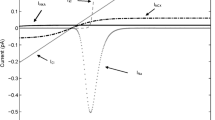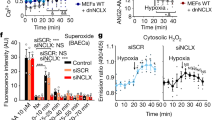Summary
Loss of cellular ion homeostasis during anoxia, with rapid downhill fluxes of K+, Ca2+, Na+ and Cl-, is preceded by a slow rise in extracellular K+ concentration (K +e ), probably reflecting early activation of a K+ conductance. It has been proposed that this conductance is activated by either a rise in intracellular calcium concentration (Ca 2+i ), or by a fall in ATP concentration. In a previous study from this laboratory (Folbergrová et al. 1990) we explored whether the early activation of a K+ conductance could be triggered by a rise in Ca 2+i . To that end, labile metabolites and phosphorylase a, a calcium sensitive enzyme, were measured after 15, 30, 60 and 120 s of complete ischemia (“anoxia”). In the present study, we investigated whether brief anoxia is accompanied by changes in ATP/ADP ratio, or in the phosphate potential, which could cause activation of a K+ conductance. To provide information on this issue, we added a group with 45 s of anoxia to the previously reported groups, and derived changes in intracellular pH (pHi). This allowed calculations of the free concentrations of ADP (ADPf) and AMP (AMPf) from the creatine kinase and adenylate kinase equilibria, and hence the derivation of ATP/ADPf ratios. In performing these calculations we initially assumed that the free intracellular Mg2+ concentration remained unchanged at 1 mM. However we also explored how a change in Mg 2+i of the type described by Brooks and Bachelard (1989) influenced the calculation. The results showed that ADPf must have risen to 150–200% of control within 15 s, and to 330–350% of control within 45 s of anoxia. The concentration of AMPf should have increased 2–4 fold in 15 s and 10–20 fold in 45 s. Thus although tissue ATP concentration usually remains >90% of control within the first 30s of anoxia, and >80% of control within the first 45 s, the ATP/ADPf ratios change markedly at a time when alterations in ion homeostasis are dominated by a moderate rise in K +e , and long before massive ion fluxes occur and the cells depolarise (after about 60–70 s). Such early changes in ATP/ADPf ratio, or in phosphate potential, could well influence reactions which are coupled to ATP hydrolysis, and perhaps lead to activation of ATP-dependent K+ conductances.
Similar content being viewed by others
References
Alberty RA (1968) Effect of pH and metal ion concentration on the equilibrium hydrolysis of adenosine triphosphate to adenosine diphosphate. J Biol Chem 243:1337–1343
Ashcroft FM (1988) Adenosine 5′-triphosphate-sensitive potassium channels. Ann Rev Neurosci 11:97–118
Ashford MLJ, Sturgess NC, Trout NJ, Gardner NJ, Hales CN (1988) Adenosine-5′-triphosphate-sensitive ion channels in neonatal rat cultured central neurones. Pflügers Arch 412:297–304
Ben-Ari Y (1990) Hippocampal potassium ATP channels and anoxia: presynaptic, postsynaptic or both? TINS 13:409–410
Ben-Ari Y, Krnjevic K, Cre'pel V (1990) Activators of ATP-sensitive K+ channels reduce anoxic depolarisation in CA3 hippocampal neurones. Neuroscience 37:55–60
Ben-Yoseph O, Bachelard HS, Bada-Goffer RS, Dolin SJ, Morris PG (1990) Effects of N-methyl-D-aspartat on [Ca 2+i ] and the energy state in the brain by 19F- and 31P-nuclear magnetic resonance spectroscopy. J Neurochem 55:1446–1449
Brooks KJ, Bachelard HS (1989) Changes in intracellular free magnesium during hypoglycaemia and hypoxia in cerebral tissue as calculated from 31P-nuclear magnetic resonance spectra. J Neurochem 53:331–334
Duchen MR (1990) Effects of metabolic inhibition on the membrane properties of isolated mouse primary sensory neurones. J Physiol 424:387–409
Dunne MJ, Petersen OH (1986) Intracellular ADP activates K+ channels that are inhibited by ATP in an insulin-secreting cell line. FEBS letters 208:59–62
Ekholm NA, Katsura K, Siesjö BK (1990) Tissue lactate content and tissue PCO2 in complete brain ischemia: implications for compartmentation of H+. Neurological Research
Erecinska M, Silver IA (1989) ATP and brain function. JCBF 9:2–19
Fagg GE (1985) L-Glutamate, excitatory amino acid receptors and brain function. TINS 8:207–210
Fagg GE, Foster AC, Ganong AH (1986) Excitatory amino acid synaptic mechanisms and neurological function. TIPS 7:357–363
Folbergrová J, MacMillan V, Siesjö BK (1972) The effect of moderate and marked hypercapnia upon the energy state and upon the cytoplasmic NADH/NAD+ ratio of the rat brain. J Neurochem 19:2497–2505
Folbergrová J, Minamisawa H, Ekholm A, Siesjö BK (1990) Phosphorylase a and labile metabolites during anoxia: correlation to membranefluxes of K+ and Ca2+. J Neurochem 55:1690–1696
Gehlert DR, Mais DE, Gackenheimer SL, Krushinski JH, Robertson DW (1990) Localization of ATP sensitive potassium channels in the rat brain using a novel radioligand, [125I] iodoglibenclamide. Eur J Pharmacol 186:373–375
Hansen AJ (1985) Effects of anoxia on ion distribution in the brain. Physiol Rev 65:101–148
Hansen AJ, Hounsgaard J, Jansen H (1982) Anoxia increases potassium conductance in hippocampal nerve cells. Acta Physiol Scand 115:301–310
Hochachka PW, Mommsen TP (1983) Protons and anaerobiosis. Science 219:1391–1397
Kakei M, Kelly RP, Ashcroft SJH, Ashcroft FM (1986) The ATP-sensitivity of K+ channels in rat pancreatic β-cells is modulated by ADP. FEBS Lett 208:63–66
Katsura K, Ekholm NA, Asplund B, Siesjö BK (1991) Extracellular pH in the brain during ischemia: relationship to the severity of lactic acidosis. J Cereb Blood Flow Metab 11:597–599
Kraig RP, Pulsinelli WA, Plum F (1986) Carbonic acid buffer changes during complete brain ischemia. Am J Physiol 250:R348-R357
Krnjevic K (1975) Coupling of neuronal metabolism and electrical activity. Ingvar DH, Lassen NA (eds) Brain work: the coupling of function, metabolism and blood flow in the brain. Munksgaard, Copenhagen, pp 65–78
Krnjevic K, Leblond J (1987) Anoxia reversibly suppresses neuronal calcium currents in rat hippocampal slices. Can J Physiol Pharmacol 65:2157–2161
Lawson JWR, Veech RL (1979) Effects of pH and free Mg2+ on the K eq of the creatine kinase reaction and other phosphate hydrolases and phosphate transfer reactions. J Biol Chem 254:6528–6537
Lowry OH, Passoneau JV, Hasselberger FK, Schultz DW (1964) Effect of ischemia on known substrates and cofactors of the glycolytic pathway in brain. J Biol Chem 239:18–30
Mayer ML, Westbrook GL (1987) Cellular mechanisms underlying excitotoxicity. TINS 10:59–61
McIntosh TK, Vink R, Soares H, Hayes R, Simon R (1990) Effect of noncompetitive blockade of N-methyl-D-aspartat receptors on the neurochemical sequelae of experimental brain injury. J Neurochem 55:1170–1179
Misler S, Falke LC, Gillis K, McDaniel ML (1986) A metabolite-regulated potassium channel in rat pancreatic β cells. Proc Natl Acad Sci 83:7119–7123
Mourre C, Ben-Ari Y, Bernardi H, Fosset M, Lazdunski M (1989) Antidiabetic sulfonylureas: localization of binding sites in the brain and effects on the hyperpolarisation induced by anoxia in hippocampal slices. Brain Res 486:159–164
Nicholls D, Attwell D (1990) The release and uptake of excitatory amino acids. TIPS 11:462–468
Nicholson C (1980) Dynamics of the brain cell microenvironment. Neurosci Res Program Bull 18:177–322
Nilsson B, Norberg K, Nordström C-H, Siesjö BK (1975) Rate of energy utilization in the cerbral cortex of rats. Acta Physiol Scand 93:569–571
Noma A (1983) ATP-regulated K+ channels in cardiac muscle. Nature 305:147–148
Siesjö BK (1985) Acid-base homeostasis in the brain: physiology, chemistry, and neurochemical pathology. In: Kogure K, Siesjö Hossmann K-A, Welsh F (eds) Progress in brain research, Vol 63. Elsevier Science Publishers BV (Biomedical Division), North Holland, pp 121–154
Siesjö BK (1990) Calcium, excitotoxins, and brain damage. NIPS 5:120–125
Siesjö BK, Folbergrová J, MacMillan V (1972) The effect of hypercapnia upon intracellular pH in the brain, evaluated by the bicarbonate-carbonic acid method and from the creatine phosphokinase equilibrium. J Neurochem 19:2483–2495
Siesjö BK (1988) Acidosis and ischemic brain damage. Neurochem Pathol 9:31–88
Silver IA, Erecinska M (1990) Intracellular and extracellular changes of [Ca2+] in hypoxia and ischemia in rat brain in vivo. J Gen Physiol 95:837–866
Uematsu D, Greenberg JH, Reivich M, Kobayashi S, Karp A (1988) In vivo fluorometric measurement of changes in cytosolic free calcium from the cat cortex during anoxia. J Cereb Blood Flow Metab 8:367–374
Veech RL, Lawson JW, Cornell NW, Krebs HA (1979) Cytosolic phosphorylation potential. J Biol Chem 254:6538–6547
Veloso D, Guynn RW, Oskarsson M, Veech RL (1973) The concentrations of free and bound magnesium in rat tissue. J Biol Chem 248:4811–4819
Vink R, Faden AI, McIntosh TK (1988) Changes in cellular bioenergetic state following graded traumatic brain injury in rats: determination by phosphorus 31 magnetic resonance < spectroscopy. J Neurotrauma 4:315–330
Wyman J (1948) Heme proteins. Adv Protein Chem 4:407–531
Author information
Authors and Affiliations
Rights and permissions
About this article
Cite this article
Ekholm, A., Asplund, B. & Siesjö, B.K. Perturbation of cellular energy state in complete ischemia: Relationship to dissipative ion fluxes. Exp Brain Res 90, 47–53 (1992). https://doi.org/10.1007/BF00229255
Received:
Accepted:
Issue Date:
DOI: https://doi.org/10.1007/BF00229255




